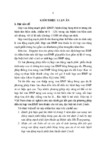
Please use this identifier to cite or link to this item:
http://dulieuso.hmu.edu.vn/handle/hmu/2221| Title: | Nghiên cứu kết quả nong van động mạch phổi bằng bóng qua da ở trẻ em dưới 2 tuổi hẹp van động mạch phổi đơn thuần |
| Authors: | LÊ HỒNG, QUANG |
| Advisor: | GS.TS. Phạm Gia, Khải PGS.TS. Phạm Hữu, Hòa |
| Keywords: | 62720135;Nhi khoa |
| Issue Date: | 2016 |
| Abstract: | THÔNG TIN TÓM TẮT NHỮNG KẾT LUẬN MỚI. CỦA LUẬN ÁN TIẾN SĨ. Tên đề tài: “Nghiên cứu kết quả nong van động mạch phổi bằng bóng qua da ở trẻ em dưới 2 tuổi hẹp van động mạch phổi đơn thuần”.. Mã số: 62720135; Chuyên ngành: Nhi khoa. Nghiên cứu sinh: LÊ HỒNG QUANG. Người hướng dẫn: 1. GS.TS. Phạm Gia Khải. 2. PGS.TS. Phạm Hữu Hòa. Cơ sở đào tạo: Trường Đại học Y Hà Nội.. Những kết luận mới của luận án: . 1. Cần có thái độ xử trí tích cực trong bệnh hẹp van động mạch phổi đơn thuần ở trẻ nhỏ:. - Điều trị nong van động mạch phổi (ĐMP) bằng bóng qua da cho những trẻ có hẹp van ĐMP đơn thuần với mức độ hẹp trung bình đến nặng là lựa chọn hàng đầu với tỷ lệ thành công cao.. - Nong van động mạch phổi nhiều lần với kích thước bóng lớn dần, tỷ lệ đường kính bóng và vòng van ĐMP (lớn nhất) từ 1,2 - 1,39 được lựa chọn cho phép tỷ lệ tái hẹp van, hở van động mạch phổi chấp nhận được.. - Khi đưa bóng lên vị trí van ĐMP mà thấy cản trở thì rút bóng về rồi làm lại từ đầu, để tránh bóng đi phía dưới dây chằng, cột cơ của van ba lá, gây đứt dây chằng van ba lá.. 2. Theo dõi định kỳ sau can thiệp nong van ĐMP:. - Sau nong van động mạch phổi bệnh nhân cần được theo dõi định kỳ, đặc biệt trong 6 tháng đầu phát hiện tái hẹp để nong lại van phổi kịp thời. Hở phổi sau nong van thường ở mức độ nhẹ và trung bình nhưng cần theo dõi lâu dài trong nhiều năm.. - Phát hiện và theo dõi những tai biến như tắc mạch, hở van ĐMP nặng, rối loạn nhịp, đứt dây chằng van ba lá để có kế hoạch điều trị.. Người hướng dẫn GS.TS. PHẠM GIA KHẢI Nghiên cứu sinh LÊ HỒNG QUANG THE INFORMATION SUMMARIZES THE NEW CONCLUSIONS OF THE THESIS. The name thesis: "Percutaneous balloon dilatation for typical pulmonary valve stenosis in children aged less than two years old". Code: 62720135 Specialization: Pediatrics. PhD students: Le Hong Quang. Supervisor of science:. Professor. Pham Gia Khai. A/ Professor. Pham Huu Hoa. Training facility: Ha Noi Medical University. New results of doctoral dissertation:. 1. HavBalloon dilatation for pulmonary valve stenosis should be a treatment of choice for children with moderate and severe typical pulmonary stenosis with rate high successfuly.Percutaneous balloon dilatation for pulmonary valve stenosis with diameter of balloon is increased and the balloon-to-valve ring diameter ratio of 1.2 - 1.39 is used, then the degree of pulmonary valve insufficient and rate re-stenosis is acceptable.. If there is an obstruction while putting the balloon to the pulmonary valve position, withdraw the balloon and restart the process to avoid balloon going under tricuspid valve papillary muscle that causes the rapture of tricuspid valve papillary muscle.. 2. Regular follow-up after pulmonary valve dilatationAfter percutaneous balloon dilatation for pulmonary valve stenosis, a follow-up is required for patients for identify patients with re-stenosis in 6 months after balloon dilatation for repeated balloon dilatation. Pulmonary valve regugitation after balloon dilatation is mild and moderate, but patients are required a long term follow-up.. Identifying and monitoring the complications such as thrombosis, severe pulmonary valve insufficiency, arrhythmias, rupture of tricuspid valve papillary muscle in order to have proper treatment Supervisor of science Professor. Pham Gia Khai Ph. Student Le Hong Quang . |
| URI: | http://dulieuso.hmu.edu.vn//handle/hmu/2221 |
| Appears in Collections: | Luận án (nghiên cứu sinh) |
Files in This Item:
| File | Description | Size | Format | |
|---|---|---|---|---|
| 164_LEHONGQUANG-TV.pdf Restricted Access | 3.55 MB | Adobe PDF |  Sign in to read | |
| 164_LeHongQuang_tt(1).pdf Restricted Access | 1.06 MB | Adobe PDF |  Sign in to read |
Items in DSpace are protected by copyright, with all rights reserved, unless otherwise indicated.